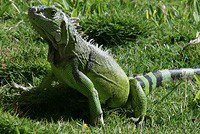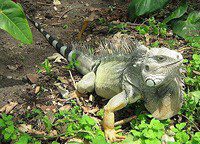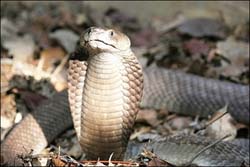
iguana real
A real iguana among connoisseurs is also known under the name green – because of the predominant color in the body color – and ordinary. However, it is unlikely that anyone will be able to characterize the appearance and other signs of this animal with the second name. This large herbivorous lizard has a calm nature and easily takes root in captivity, so it is quite popular among exotic lovers. And yet, it cannot be said that keeping a real iguana at home is simple and easy. Like any other exotic lizard, it needs to create suitable conditions, at least a specially equipped terrarium and an appropriate climate with lighting. A real iguana, like other members of the family, is distinguished, for example, from agamas and chameleons, by the structure of the teeth. In iguanas, the teeth are attached to the jaw not with an expanded top, but as if sideways. The coloring of the body of a real iguana is quite bright, so this lizard is beautiful in its own way. It originates from Central and South America. In size, a real iguana can be called medium, but there are also large two-meter and eight-kilogram individuals.
Contents
Classification
Kingdom: Animals
Type: Chord
Class: Reptiles
Order: Scaly
Suborder: Lizards
Family: Iguana
Genus: Real iguanas
Species: Common iguana, Iguana iguana
Appearance
The size of the body of a real iguana is directly related to the conditions of its habitat. Standard characteristics – torso 1 meters, weight 5-5 kg. But in the humid South American forests, rich in plant foods, the aforementioned giants are also found. But in arid conditions, for example, on the islands, the size of a real iguana is 7% smaller than mainland individuals. Newborn real iguanas reach only 30-15 cm in length, and weigh no more than 25 g. Moreover, the green color of the skin cannot be called characteristic of all members of the species, it can also vary depending on the living conditions and life expectancy of the lizard. Southern true iguanas are predominantly bluish with black spots all over their bodies. Among island reptiles there are green, black, lilac and even pinkish iguanas, northern lizards can be reddish or orange, and Central American iguanas are bright blue when young, but change color with age.
The body shape of real iguanas is narrow, the body continues with a long and flattened tail on the sides. A horny crest runs along the entire ridge, and there is a leathery bag on the throat. The paws of real iguanas are not long with sharp claws to deftly climb trees. Leathery shields on the head, and transverse rows of scales on the body. By the way, the tail of real iguanas, like many other lizards, tends to fall off, for example, if some enemy clings to it, but then grows back.
Sexual dimorphism in lizards is not particularly pronounced, but in males the spiny scales on the tail are longer than in females, as well as a more developed crest. In general, males are larger, massive and brighter. The teeth of a real iguana, due to their sharpness, could become a dangerous weapon, however, she rarely uses them, using them only for chewing plant food. In shape, they resemble a leaf and are, as it were, hidden behind the jaw bones. Like marine iguanas, real lizards also know how to sneeze, removing excess salt from the body with moisture. Some Mexican individuals have small horns in the area of the eyes and nostrils.
Young iguanas are most often bright green, this coloration is camouflage, so it is not easy to see the iguana in the tree. And dark stripes on the body allow the lizards to become invisible when they hide in various vegetation. Sometimes iguanas change skin color, for example, from stress, changes in temperature or lighting, but only in certain areas of the body.
Distribution and habitation
 Among other iguanas, the real iguana is perhaps the most common on the South American mainland. It is mainly found in the tropics, such as southern Mexico. Further, the range continues to central Brazil and countries such as Paraguay, Bolivia, and in the eastern part of the mainland it even covers the nearest islands – Grenada, Trinidad and Tobago, Guadeloupe, Aruba, St. Vincent, etc. The real iguana was introduced into North America artificially, but today it can be found in the southern and coastal parts of the mainland, for example, in Florida, Texas, Hawaii, as well as in the Antilles, American and Virgin Islands. In general, a real iguana settles wherever there is woody vegetation and enough moisture. It can be found in the rainforest, and in open coastal space or in thickets near river reservoirs. And almost all the time the lizard spends on trees, closer to the crown, where there is most of the sun. Only in cool weather do real iguanas descend to the ground. And sometimes the lizard uses the nearest body of water to swim freely, and she does it surprisingly cleverly.
Among other iguanas, the real iguana is perhaps the most common on the South American mainland. It is mainly found in the tropics, such as southern Mexico. Further, the range continues to central Brazil and countries such as Paraguay, Bolivia, and in the eastern part of the mainland it even covers the nearest islands – Grenada, Trinidad and Tobago, Guadeloupe, Aruba, St. Vincent, etc. The real iguana was introduced into North America artificially, but today it can be found in the southern and coastal parts of the mainland, for example, in Florida, Texas, Hawaii, as well as in the Antilles, American and Virgin Islands. In general, a real iguana settles wherever there is woody vegetation and enough moisture. It can be found in the rainforest, and in open coastal space or in thickets near river reservoirs. And almost all the time the lizard spends on trees, closer to the crown, where there is most of the sun. Only in cool weather do real iguanas descend to the ground. And sometimes the lizard uses the nearest body of water to swim freely, and she does it surprisingly cleverly.
Behavior and lifestyle
 Real iguanas climb trees perfectly and are not afraid of great heights, falling from which they almost always survive, and even in flight they try to cling to branches or leaves with their claws. The main activity in lizards is manifested during the day, as they see poorly in the dark. But the daytime vision of real iguanas is simply fantastic. The researchers noticed that the lizards generally avoid darkness and try to get out into more lit spaces if, for example, they are moved to a darkened part of the room. And whether the right amount of light around, real iguanas determine with the help of the “third eye”, located at the very top of the photosensitive rudimentary organ, which today is only able to respond to lighting and sudden movements – with its help, iguanas manage to avoid sudden attacks of a predator. Iguanas also have excellent hearing, so they immediately react to even the lightest sounds. True, with jumps in body temperature down or up, the hearing of lizards worsens. The sense of smell in real iguanas is also good. So all the senses allow her to quickly recognize the danger and hide from it in the water. Although moisture is not as important for adults as for young ones, therefore young growth lives much lower on the trees, closer to moist ground.
Real iguanas climb trees perfectly and are not afraid of great heights, falling from which they almost always survive, and even in flight they try to cling to branches or leaves with their claws. The main activity in lizards is manifested during the day, as they see poorly in the dark. But the daytime vision of real iguanas is simply fantastic. The researchers noticed that the lizards generally avoid darkness and try to get out into more lit spaces if, for example, they are moved to a darkened part of the room. And whether the right amount of light around, real iguanas determine with the help of the “third eye”, located at the very top of the photosensitive rudimentary organ, which today is only able to respond to lighting and sudden movements – with its help, iguanas manage to avoid sudden attacks of a predator. Iguanas also have excellent hearing, so they immediately react to even the lightest sounds. True, with jumps in body temperature down or up, the hearing of lizards worsens. The sense of smell in real iguanas is also good. So all the senses allow her to quickly recognize the danger and hide from it in the water. Although moisture is not as important for adults as for young ones, therefore young growth lives much lower on the trees, closer to moist ground.
 And iguanas swim in a very peculiar way, vibrating their tail in different directions. Even lizards are able to move quickly on land, but if they failed to escape from the enemy, then they will defend themselves aggressively and with remarkable strength, trying to hit with their tail, bite or scratch. Real iguanas spend the night not very high in the trees, but at dawn they climb higher to sunbathe or search for food. Male lizards often arrange fights for territory or demonstration battles for females. And for the local population, real iguanas are the object of hunting, as they have quite tasty meat. But to catch a lizard, and even more so to pick it up, is not so easy. Sometimes the diet of real iguanas has a harmful effect on the environment, as they are able to destroy rare plant species or occupy the burrows of rare and protected animals, such as the burrowing owl. And it is known about the life expectancy of lizards that in captivity they live much longer – up to 20 years, while in the wild they rarely live even up to 8 years.
And iguanas swim in a very peculiar way, vibrating their tail in different directions. Even lizards are able to move quickly on land, but if they failed to escape from the enemy, then they will defend themselves aggressively and with remarkable strength, trying to hit with their tail, bite or scratch. Real iguanas spend the night not very high in the trees, but at dawn they climb higher to sunbathe or search for food. Male lizards often arrange fights for territory or demonstration battles for females. And for the local population, real iguanas are the object of hunting, as they have quite tasty meat. But to catch a lizard, and even more so to pick it up, is not so easy. Sometimes the diet of real iguanas has a harmful effect on the environment, as they are able to destroy rare plant species or occupy the burrows of rare and protected animals, such as the burrowing owl. And it is known about the life expectancy of lizards that in captivity they live much longer – up to 20 years, while in the wild they rarely live even up to 8 years.
Food
 In terms of nutrition, real iguanas are absolute vegetarians. Their food is various tropical vegetation – leaves, shoots, flowers and fruits. Jamaican plum, frankincense and other exotic plants are among the most favorite delicacies. Young iguanas are characterized by coprophagia, which is necessary for them to digest plant foods and get the missing calories. Real iguanas do not know how to chew, they only tear off parts of plants with sharp teeth and swallow them whole, and get water either from the nearest reservoir or by licking wet greens. Sometimes insects and small invertebrates are found in the stomachs of lizards, from which scientists concluded that iguanas also eat animal food. However, in the end it turned out that these creatures are swallowed by lizards by chance along with the plants in which they hide. But in captivity, real iguanas are sometimes fed with rodent meat, though in very small quantities, since a protein diet adversely affects the health of lizards.
In terms of nutrition, real iguanas are absolute vegetarians. Their food is various tropical vegetation – leaves, shoots, flowers and fruits. Jamaican plum, frankincense and other exotic plants are among the most favorite delicacies. Young iguanas are characterized by coprophagia, which is necessary for them to digest plant foods and get the missing calories. Real iguanas do not know how to chew, they only tear off parts of plants with sharp teeth and swallow them whole, and get water either from the nearest reservoir or by licking wet greens. Sometimes insects and small invertebrates are found in the stomachs of lizards, from which scientists concluded that iguanas also eat animal food. However, in the end it turned out that these creatures are swallowed by lizards by chance along with the plants in which they hide. But in captivity, real iguanas are sometimes fed with rodent meat, though in very small quantities, since a protein diet adversely affects the health of lizards.
Reproduction
 Sexual maturity occurs in true iguanas at the age of 3 or 4 years. But sometimes they are able to reproduce even earlier. The breeding season for lizards usually begins in the winter months, but varies in different areas. For example, in arid areas, the mating games of real iguanas begin at the very beginning of the drought, and clutches are made towards the end. Offspring are born during the rainy season, when there is more available food. When the breeding season approaches, the males of real iguanas begin to actively look for females, and when they find them, they arrange demonstrative fights, which for some lizards end in failure. But if there is an escape route, the defeated enemy runs away.
Sexual maturity occurs in true iguanas at the age of 3 or 4 years. But sometimes they are able to reproduce even earlier. The breeding season for lizards usually begins in the winter months, but varies in different areas. For example, in arid areas, the mating games of real iguanas begin at the very beginning of the drought, and clutches are made towards the end. Offspring are born during the rainy season, when there is more available food. When the breeding season approaches, the males of real iguanas begin to actively look for females, and when they find them, they arrange demonstrative fights, which for some lizards end in failure. But if there is an escape route, the defeated enemy runs away.
The place of future mating is also chosen by males, and then they mark the chosen territory with a special secret from the pores on their paws. And finally, courtship begins, more precisely, “show performances” of males when they become brighter and widely inflate their throats. For real iguanas, as well as for marine ones, harems are characteristic, moreover, both with several females and with several males. There are also special caresses when males sniff their chosen ones and bite their neck.
The gestation time for female true iguanas is about two months, and when it comes to laying, the females move upstream the waters near which they live and look for dry sandbanks or hills. The clutch is arranged in a deep hole, which the female digs herself and where she lays many eggs for three days. They can be from 20 to 70 pieces – in a white leathery shell, soft, but strong enough. And real iguanas are also characterized by common incubators, when several females lay their eggs in one hole, and then bury it and leave it, no longer returning to this place. In real iguanas, care for offspring is not expressed in any way. Eggs are in the ground for about 3-4 months. In order for small iguanas to be born, they need to break through the shell with the help of a fleshy “horn” on their forehead, and only then they get to the surface.
In color, the cubs of real iguanas are similar to adults, however, their comb is much less developed. Nature arranged it so that for the survival of the young of real iguanas, parental care is not required. Newborn lizards often carry a yolk sac with their first supply of nutrients. And young animals prefer to grow together, since in this case real iguanas are more likely to survive, and young males even cover females from predators with their own bodies – an amazing and unique feature that is characteristic only of real iguanas. But not all masonry have time to “realize” their purpose. Many of them are destroyed by the local population, who consider iguana eggs a special delicacy.
Sources of
http://ru.wikipedia.org
http://www.zoocom.ru/
http://zoolife.com.ua/
http://moikompas.ru/
http://www.zooclub.ru





